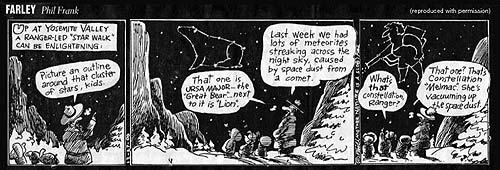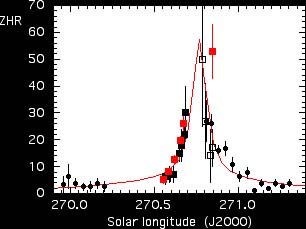|
Leonid MAC |
| home |
| View the shower |
| Mission Brief |
| Science Update |
| Media Brief |
| links |
LEONID DAILY NEWS: December 25, 2000
 San Francisco Chronicle - 12/27/00
San Francisco Chronicle - 12/27/00
 Figure Left: Compilation of Zenith Hourly Rate estimates for the 2000 Ursid shower. The
figure contains the IMO averages in red (see below) and measurements from
24 observers in Japan (black circle -compiled by Masaaki Takanashi of the Nippon
Meteor Society), several observers of the Dutch Meteor Society (black square - compiled
by Marco Langbroek), and visual counts by Peter Jenniskens in California
(open square). Line is a best fit Lorentz profile.
Figure Left: Compilation of Zenith Hourly Rate estimates for the 2000 Ursid shower. The
figure contains the IMO averages in red (see below) and measurements from
24 observers in Japan (black circle -compiled by Masaaki Takanashi of the Nippon
Meteor Society), several observers of the Dutch Meteor Society (black square - compiled
by Marco Langbroek), and visual counts by Peter Jenniskens in California
(open square). Line is a best fit Lorentz profile.
The 2000 return of this shower was eagerly awaited because an enhanced activity was expected. Indeed, the rates were significantly higher than the average. The last reported Ursid activity enhancement occurred on Dec. 22, 1996 at solar long. 270.7 with ZHR of the order of 30 (But see graph right, few US observations included -PJ). In 2000 the conditions were good as the Moon was almost new. The long northern nights allow a good overlap. Unfortunately, this first summary indicates that the most interesting period is not well covered. Most European observers had to finish around 6h UT (morning twilight). The number of North American data is scarce so far. As a consequence, we cannot yet achieve a good profile. Below find the preliminary data. The high ZHR at the end agrees with Japanese data published here before, although the errors are still quite large. We are very grateful to the following 15 observers who sent in their reports in time for this first activity overview: ARLRA Rainer Arlt (Germany), BADPI Pierre Bader (Germany), BUCAN Andreas Buchmann (Switzerland), CANED Ed Cannon (USA), ENZFR Frank Enzlein (Germany), HOSDA Dave Hostetter (USA), LANMA Marco Langbroek (Netherlands), LUNRO Robert Lunsford (USA), LUTHA Hartwig Luthen (Germany), MOLSI Sirko Molau (Germany), OSAKA Kazuhiro Osada (Japan), PUNMI Milesh Puntambekar (India), RENJU Jurgen Rendtel (Germany), STOEN Enrico Stomeo (Italy), ZHUJI Jin Zhu (China)
----------------------------------------------------------------------------------
Date Time (UT) Sollong nObs nIND nURS ZHR +/-
----------------------------------------------------------------------------------
Dec 22 0240 270.553 5 4 16 5.1 +- 1.2
22 0330 270.586 12 9 46 8.2 1.2
22 0410 270.620 16 9 76 12.7 1.5
22 0510 270.658 16 10 104 19.6 1.9
22 0535 270.676 8 6 58 26.1 3.4
22 0935 270.847 2 2 29 53 10
Solar longitudes refer to equinox J2000.0. nObs is the number of
individual observing periods, nIND is the number of individual
observers providing them, nURS is the number of Ursids seen. The
population index used was r=2.5. The expectation value of the ZHR,
ZHR = (1 + sum nGEM) / sum(Teff/C), was used for the averages here, where Teff is the effective observing time and C is the total correction composed of limiting magnitude, clouds, and zenith correction [sin (h_R)]. Times are rounded to the nearest 10 minutes. - Juergen Rendtel, International Meteor Organization (December 25, 2000). Dec. 25 - Ursid shower circular IMO Dec. 24 - Ursid shows early release of sodium Dec. 23 - Ursid outburst confirmed Dec. 18 - Dec 22 Ursid outburst Nov. 20 - A bacterial fingerprint? Nov. 15 - HCN disappears mysteriously Nov. 14 - Meteor shower from space Nov. 13 - Organic fingerprint Nov. 12 - Train airglow chemistry Nov. 11 - Hard bits and persisting glows Nov. 10 - Meteoroid debris detected Nov. 09 - New meteor picture Nov. 08 - Spin city Nov. 07 - Meteors affect atmospheric chemistry Nov. 06 - Listen to this! Nov. 04 - Fear of heights? Nov. 03 - The pale (infra-red) dot Nov. 02 - Twin showers Nov. 01 - Leonids approaching Earth Oct. 31 - Prospects for Moon Impact Studies Oct. 30 - Comet dust crumbled less fine Today's news
| ||

